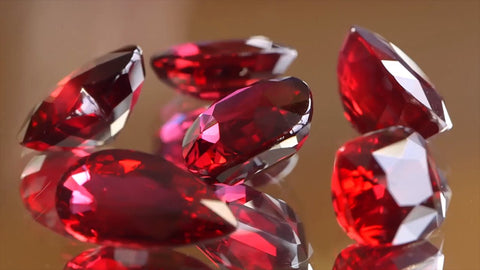The complete Ruby buying guide

Throughout history, rubies have been the most sought-after red gemstone. Their hardness and durability make them ideal for daily wear, whether as an engagement ring, earrings, pendants, or bracelets. They look beautiful in any form. For colourful gemstones, natural rubies are frequently the most expensive, and ruby prices are on the rise.
Choosing the right ruby might be a challenge because there are so many to choose from. If you want to know if the ruby is the perfect choice for you, you need to be aware of its features. We have covered it all in this Ruby buying guide.
Ruby buying guide - Definition
The Latin word 'ruber', which means red, is the source of the word ruby. It was given this name because of the color's richness and intensity. When the mineral corundum is subjected to chromium oxide at extremely high temperatures deep underground, rubies are created.
Ruby buying guide - Sources
Large rock formations and mountain ranges have deep crevices and cracks where this exposure occurs. Myanmar, Thailand, Australia, and Afghanistan are the primary sources of natural rubies, but the gems have also been found in other places of Europe, South America, and the United States.
Ruby buying guide - Color
If you want to buy a ruby, color is the most significant consideration. Corundum is the same substance used to make rubies and sapphires. The only colour of corundum that doesn't fall under the designation sapphire is red, which gets the honour of being referred to as ruby.
The primary hue of a ruby is red, although secondary colours such as pink, purple, or orange can also be found in rubies. The less expensive the stone, the more purple or orange it is.
Pigeon blood red rubies are the most sought-after of all rubies because of their deep red colour. Despite their rarity, pigeon blood rubies are among the most expensive gems on the market.
Color is graded by hue, saturation, and tone in accordance with the GIA:
It is the stone's primary colour that is referred to as hue. In order to be a high-quality ruby, it must be red in colour.
Saturation is the degree to which a color's intensity is enhanced. On a scale of one to six, this is rated. Brown or greyish colours can be seen in low-intensity colours whereas colourful and bold colours can be seen in high-intensity colours.
In the grading scale, the darker or lighter a stone's tone is, the higher or lower the grade it receives.
An excellent ruby will be red in the majority, have a high level of saturation, and have a dark tone. The ruby's colour grade will be listed as R 6/6 on the certificate. Having a ruby like this would be extremely valuable and command a higher price point.
Ruby buying guide - Clarity
Inclusions are found in all natural gemstones, including diamonds. Depending on the material, these inclusions can be gas bubbles, liquid, or minuscule amounts of other minerals.
A ruby's clarity can be determined by looking for any visible inclusions. It doesn't matter if a ruby has visible inclusions or if they are hidden in the stone. If there are any inclusions in the stone, be sure they are not located in regions that could undermine its structural integrity. The less inclusions there are in a stone, the more valuable it is.
Ruby buying guide - Inclusions
Inclusions can provide a star-like look on rubies in some situations. Asterism is a result of the stone's needle-like inclusions crossing and causing this effect. On the surface of the stone, the star might appear as a three- or six-pointed star. Asterism in rubies necessitates meticulous cutting to bring out the star's full splendour. In the majority of cases, they are carved into cabochons.

Ruby buying guide - Carat
The majority of rubies are smaller than one or two carats in weight. Larger rubies are extremely rare and consequently quite pricey. To add glamour and refinement to a piece of jewellery, even the most petite rubies can be used in a creative way.

There are synthetic rubies that may be of interest to those looking for a huge ruby. These are frequently greater in size and less expensive than real rubies.
Ruby buying guide - Origin
Some of the world's most famous ruby mines are located in Asia and Africa, including Myanmar, Cambodia, Thailand, Sri Lanka, Mozambique, Zambia, and Pakistan. As a result, the Burmese rubies of Burma, also known as Myanmar, have long been regarded as the best rubies in the world.
As a result, Burmese rubies have become increasingly scarce and more expensive. At auctions, an unheated Burmese ruby can sell for about $1 million per carat. Known for their beauty and superb quality, they boast a powerful fluorescence. Those looking for the best ruby should go for a Burmese ruby.
It is commonly accepted that Indian rubies are less expensive and deeper in colour. As the most affordable ruby variant, it is frequently used in costume jewellery.
There you have it, the complete Ruby buying guide! Head onto www.irisgems.com and find the most perfect Ruby gem for you or loved one.


